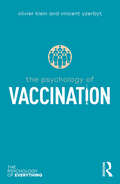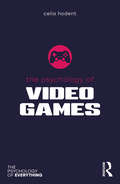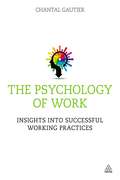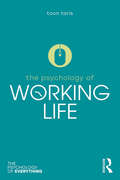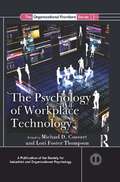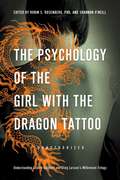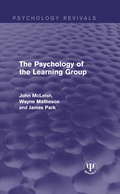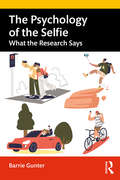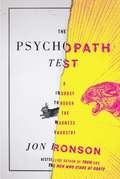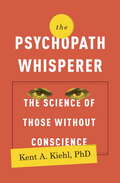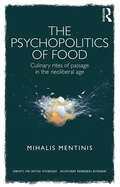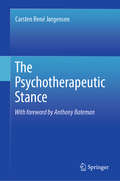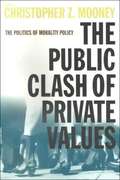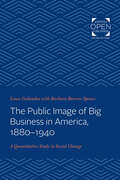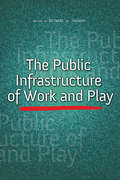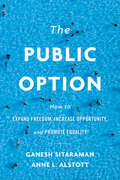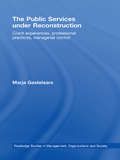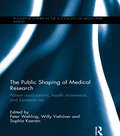- Table View
- List View
The Psychology of Vaccination (The Psychology of Everything)
by Vincent Yzerbyt Olivier KleinWhy do some people choose to be vaccinated and others do not? What is the difference between vaccine hesitancy and anti-vaccinism? What can social psychology tell us about attitudes towards vaccination?The Psychology of Vaccination identifies the social psychological drivers of vaccine mindsets, to explore why some people choose to be vaccinated, some are hesitant, and others refuse. It explores the socio-demographic factors related to vaccine hesitancy and considers the role of motivation in making this health decision. The book focuses on how individuals are social beings, inserted into a web of influences that guide their behaviour, and considers the impact this may have on their health choices.Not only aimed at the convinced, but also for all those who have doubts about vaccination, The Psychology of Vaccination offers an insightful look at our health behaviours and considers whether it is possible to affect health behaviour change.
The Psychology of Video Games (The Psychology of Everything)
by Celia HodentWhat impact can video games have on players? How does psychology influence video game creation? Why do some games become cultural phenomena? The Psychology of Video Games explores the relationship between psychology and video games from the perspective of both game developers and players. It looks at how games are made and what makes them fun and successful, the benefits gaming can have on players in relation to education and healthcare, concerns over potential negative impacts such as pathological gaming, and ethics considerations. With gaming being one of the most popular forms of entertainment today, The Psychology of Video Games shows the important role played by an understanding of the human brain and its mental processes in the development of ethical and inclusive video games.
The Psychology of Work
by Chantal GautierThe Psychology of Work integrates psychological theory with personal narrative from global industry leaders, as well as those entering the workforce, to offer tangible insights into the real world of work. It is ideal for students, professionals and anyone with an interest in how successful organizations operate. It charts the development of the field of organizational psychology and provides the key theoretical frameworks. Crucially, it explores how these can be utilised to enhance organizational culture, and why this is so relevant and important in the modern workplace.Through the inclusion of interviews with students, The Psychology of Work reveals what the future workforce expect of the organizations that they are going in to and encourages students reading the book to reflect on what kind of leaders they would like to be. The book is also a valuable resource to support professionals and practitioners, highlighting current working practices and the need for change, offering practical guidance on how to bring the 'humane' back into organizational life.
The Psychology of Working Life (The Psychology of Everything)
by Toon W. TarisWhat motivates us to do a good job? When does the pressure of work impact upon our health and well-being? How can employers choose the right candidates? The Psychology of Working Life shows how, whether we like it or not, the way we work, and our feelings about it, play a fundamental role in overall well-being. From the use of psychometrics in recruiting the right candidate, to making working life more efficient, the book illustrates how work in industrialized societies continues to be founded upon core psychological ideas. Motivation and job satisfaction have become recognized as key to job design and The Psychology of Working Life suggests that changing the way we work can impact on our stress levels, overall health, and productivity.
The Psychology of Workplace Technology (SIOP Organizational Frontiers Series)
by Lori Foster Thompson Michael D. CoovertRecent advances in technology have dramatically altered the manner in which organizations function, transforming the way people think about and perform their work. The implications of these trends continue to evolve as emerging innovations adapt to and are adapted by organizations, workers, and other components of the socio-technical systems in which they are embedded. A rigorous consideration of these implications is needed to understand, manage, and drive the reciprocal interplay between technology and the workplace. This edited volume brings together top scholars within and outside of the field of industrial and organizational (I-O) psychology to explore the psychological and organizational effects of contemporary workplace technologies. A special section is included at the end of the book by four experts in the field entitled Reflections and Future Directions.
The Psychology of the Girl with the Dragon Tattoo: Understanding Lisbeth Salander and Stieg Larsson's Millennium Trilogy
by Lynne McDonald-SmithLisbeth Salander, heroine of Stieg Larsson's The Girl with the Dragon Tattoo and its sequels, is one of the most compelling, complex characters of our time. Is she an avenging angel? A dangerous outlaw? What makes Salander tick, and why is our response to her—and to Larsson's Millennium trilogy—so strong? In The Psychology of the Girl with the Dragon Tattoo, 19 psychologists and psychiatrists attempt to do what even expert investigator Mikael Blomkvist could not: understand Lisbeth Salander. What does Lisbeth's infamous dragon tattoo really say about her? Why is Lisbeth so drawn to Mikael, and what would they both need to do to make a relationship work? How do we explain men like Martin Vanger, Nils Bjurman, and Alexander Zalachenko? Is Lisbeth just as sexist and as psychopathic as they are? What is it about Lisbeth that allows her to survive, even thrive, under extraordinary conditions? How is Lisbeth like a Goth-punk Rorschach test? And what do we learn about ourselves from what we see in her?
The Psychology of the Internet
by Patricia WallaceThis timely volume explores the psychological aspects of cyberspace, a virtual world in which people from around the globe are acting and interacting in many new, unusual, and occasionally alarming ways. Drawing on research in the social sciences, communications, business, and other fields, Patricia Wallace examines how the online environment can influence the way we behave, sometimes for the better, sometimes not. Our own online behavior then becomes part of the Internet's psychological environment for others, creating opportunities for shaping the way this new territory for human interaction is unfolding. Since the Internet--and our experience within it--is still young, we have a rare window of opportunity to influence the course of its development. With a new preface that incorporates many of the changes online and in the field since the hardcover edition was published, the paperback edition of The Psychology of the Internet includes the latest coverage of e-commerce, workplace surveillance and datamining, all areas of recent intense public concern. Patricia M. Wallace is Executive Director of the Center for Knowledge and Information Management at the Robert H. Smith School of Business, University of Maryland. She is author of an interactive psychology CD-ROM called PRISM and of the textbook Introduction to Psychology, Fourth Edition (with Jeffrey Goldstein). Dr. Wallace is also the principal investigator on grants from the Annenberg Projects/Corporation for Public Broadcasting dealing with language learning through CD-ROMs and the Internet.
The Psychology of the Learning Group (Psychology Revivals)
by James Park John McLeish Wayne MathesonOriginally published in 1973, this work takes a hard look at the claims made for the small group as a learning medium (lecture, structured discussion, ‘sensitivity’, training groups etc.). Various theories of group dynamics, leadership function and learning process are looked at critically on the basis of actual research findings. It was intended for students of social psychology and anyone teaching or training to teach at Further Education level at the time, and will still be of interest in its historical context today.
The Psychology of the Selfie: What the Research Says
by Barrie GunterThe Psychology of the Selfie provides a comprehensive overview and analysis of research on the significance of selfies, offering insights into the topic from a psychological perspective and examining important issues such as body image, self-objectification, mental health and psychological benefits. Selfies are a worldwide phenomenon. Although dismissed by critics as a sign of self-absorbed narcissism, they are also a social currency that maintains and reinforces friendships, a feedback loop for self-identity affirmation, a promotional tool for gaining social influence, and a method for preserving memories of life events. In this book, Barrie Gunter expertly explores the psychological underpinnings of the contemporary global phenomenon of "selfies", from the historical roots and meteoric rise due to technical advancements, to the different personality types of selfie-takers, to social relationships, to group and personal identity. Looking at both the psychological nature and impact of selfies, this book reviews different psychological outcomes for selfie-takers, both positive and negative, and the growth in psychological and physical problems that can sometimes arise. Presenting a comprehensive analysis specifically of selfie behaviour, this book is an essential reference for students and researchers in communications and media, journalism, information studies, psychology and sociology, as well as anyone with a general interest in the phenomenon.
The Psychopath Factory: How Capitalism Organizes Empathy
by Tristam AdamsThe Psychopath Factory: How Capitalism Organizes Empathy examines how the requirements, stimuli, affects and environments of work condition our empathy. In some cases, work calls for no empathy - characters who don't blink or flinch in the face of danger nor crack under pressure. In other cases, capitalism requires empathy in spades -charming, friendly, sensitive and listening managers, customer service agents and careers. When workers are required to either ignore their empathy to-do a job, or dial it up to increase productivity, they are entering a psychopathic modality. The affective blitz of work, flickering screens, emotive content, vibrating alerts and sounding alarms erode our sensitivities whilst we are modulated with attention stimulants, social lubricants and so called anti-anxiety drugs. This is amidst a virulent and exacerbating climate of competition and frenzied quantification. Capitalism pressures us to feign empathy and leverage social relationships on one hand, whilst being cold and pragmatic on the other. We are passionate and enthusiastic whilst keeping a professional distance. Sympathy, care, compassion and altruism are important; The Psychopath Factory: How Capitalism Organizes Empathy argues that itis a mistake to presuppose that empathy can achieve these. Rather than being subject to the late capitalist organization of our empathy, psychopathy could be a means of escape.
The Psychopath Test: A Journey Through the Madness Industry
by Jon RonsonIn this madcap journey, a bestselling journalist investigates psychopaths and the industry of doctors, scientists, and everyone else who studies them. The Psychopath Test is a fascinating journey through the minds of madness. Jon Ronson's exploration of a potential hoax being played on the world's top neurologists takes him, unexpectedly, into the heart of the madness industry. An influential psychologist who is convinced that many important CEOs and politicians are, in fact, psychopaths teaches Ronson how to spot these high-flying individuals by looking out for little telltale verbal and nonverbal clues. And so Ronson, armed with his new psychopath-spotting abilities, enters the corridors of power. He spends time with a death-squad leader institutionalized for mortgage fraud in Coxsackie, New York; a legendary CEO whose psychopathy has been speculated about in the press; and a patient in an asylum for the criminally insane who insists he's sane and certainly not a psychopath. Ronson not only solves the mystery of the hoax but also discovers, disturbingly, that sometimes the personalities at the helm of the madness industry are, with their drives and obsessions, as mad in their own way as those they study. And that relatively ordinary people are, more and more, defined by their maddest edges.
The Psychopath Whisperer: The Science of Those Without Conscience
by Kent A. KiehlA compelling journey into the science and behavior of psychopaths, written by the leading scientist in the field of criminal psychopathy.We know of psychopaths from chilling headlines and stories in the news and movies--from Ted Bundy and John Wayne Gacy, to Hannibal Lecter and Dexter Morgan. As Dr. Kent Kiehl shows, psychopaths can be identified by a checklist of symptoms that includes pathological lying; lack of empathy, guilt, and remorse; grandiose sense of self-worth; manipulation; and failure to accept one's actions. But why do psychopaths behave the way they do? Is it the result of their environment-- how they were raised--or is there a genetic component to their lack of conscience? This is the question Kiehl, a protégé of famed psychopath researcher Dr. Robert Hare, was determined to answer as he began his career twenty years ago. To aid in his quest to unravel the psychopathic mind, Kiehl created the first mobile functional MRI scanner to study psychopaths in prison populations. The brains of more than five hundred psychopaths and three thousand other offenders have been scanned by Kiehl's laboratory--the world's largest forensic neuroscience repository of its kind. Over the course of The Psychopath Whisperer, we follow the scientific bread crumbs that Kiehl uncovered to show that the key brain structures that correspond with emotional engagement and reactions are diminished in psychopaths, offering new clues to how to predict and treat the disorder. In The Psychopath Whisperer, Kiehl describes in fascinating detail his years working with psychopaths and studying their thought processes-- from the remorseless serial killers he meets with behind bars to children whose behavior and personality traits exhibit the early warning signs of psychopathy. Less than 1 percent of the general population meets the criteria for psychopathy. But psychopaths account for a vastly outsized proportion of violent crimes. And as Kiehl shows, many who aren't psychopaths exhibit some of the behaviors and traits associated with the condition. What do you do if you discover your roommate, or boss, or the person you are dating has traits that define a psychopath? And what does having a diminished limbic region of the brain mean for how the legal system approaches crimes committed by psychopaths? A compelling narrative of cutting-edge science, The Psychopath Whisperer will open your eyes on a fascinating but little understood world, with startling implications for society, the law, and our personal lives.From the Hardcover edition.
The Psychopolitics of Food: Culinary rites of passage in the neoliberal age (Concepts for Critical Psychology)
by Mihalis MentinisThe Psychopolitics of Food probes into the contemporary ‘foodscape’, examining culinary practices and food habits and in particular the ways in which they conflate with neoliberal political economy. It suggests that generic alimentary and culinary practices constitute technologies of the self and the body and argues that the contemporary preoccupation with food takes the form of ‘rites of passage’ that express and mark the transition from a specific stage of neoliberal development to another vis-à-vis a re-configuration of the alimentary and sexual regimes. Even though these rites of passage are taking place on the borders of cultural bi-polarities, their function, nevertheless, is precisely to define these borders as sites of a neoliberal transitional demand; that is, to produce a cultural bifurcation between ‘eating orders’ and ‘eating dis-orders’, by promoting and naturalising certain social logics while simultaneously rendering others as abject and anachronistic. The book is a worthwhile read for researchers and advanced scholars in the areas of food studies, critical psychology, anthropology and sociology.
The Psychosocial And Organization Studies
by Kate Kenny Marianna FotakiLeading authors within organization studies and also from broader social science disciplines present the state of the art in the rapidly developing field of psychosocial approaches to organization studies and critical management studies.
The Psychosocial Imaginaries of Defence Nationalism: Far-Right Extremism in Australia and the UK (Studies in the Psychosocial)
by Liam GillespieThe Psychosocial Imaginaries of Defence Nationalism interrogates the emergence of far-right nationalist 'defence leagues' in Australia and the UK. Throughout the book, Liam Gillespie refers to these groups as defence nationalists: that is, as nationalists who imagine themselves as defenders of the nation and therefore national subjects par excellence. Drawing on original research, psychoanalytic and psychosocial theory—and particularly the work of Jacques Lacan—the author explores the narratives, imaginaries and subjectivities that sustain these groups, as well as the narratives, imaginaries and subjectivities these groups sustain. He argues that unlike other nationalist groups, defence nationalists are not primarily concerned with realising their avowed political projects. Instead, they are concerned with constructing and then enjoying themselves as the nation's self-ordained defenders. This means that which threatens the nation can paradoxically have a fortifying effect upon defence nationalists, legitimising and securing both the way they see themselves, and the position they see themselves occupying with/in the nation.The Psychosocial Imaginaries of Defence Nationalism will be of interest to anyone concerned with critical theorisations of contemporary nationalism, as well as with the application of psychoanalytic and psychosocial theory to social, cultural and political analysis.
The Psychosocial Interior of the Family (Social Problems And Social Issues Ser.)
by Gerald HandelDrawing upon findings from many disciplines including sociology, communication, family studies, human development, psychology and anthropology-this book provides the first composite study of the whole family and of the complex interplay between self and collectivity in family life. It departs sharply from the traditional two-person, cause-effect models used in conventional studies, and attempts to delineate a social psychology of the family.This book undertakes to define and understand the nature of families, to point out ways of discerning different family characters, and to comprehend the processes by which these characters are established and maintained; by so doing, it introduces a new dimension into the study of family behavior and provides a framework within which meaningful investigations and practical applications can be pursued.This long-awaited fourth edition continues the goal of preceding editions: to understand families in terms of the kinds of interaction through which family life is constructed. Contributors drawn from a wide variety of disciplines sociology; communication; family studies; human development; psychology; anthropology; and social work - provide a range of authoritative and up-to-date sources on the family and interpersonal relations, including newly emergent forms of family organization. In providing a new framework for fruitful investigation and practical application, this volume contains the best available interdisciplinary work on the social psychology of the family.
The Psychotherapeutic Stance
by Carsten René JørgensenThis book provides a thorough critique of the dominating medical understanding of psychotherapy and argues for a dynamic relational understanding of psychotherapy, deeply founded in the most important results from empirical psychotherapy research. In the first part, the book critically examines the traditional focus on technical factors in psychotherapy based on available empirical research on the subject. It asks questions about whether specific techniques cure specific diagnoses or therapists and therapeutic relationships that cure persons. Part II of the book argues that the currently dominating medical understanding of psychotherapy must be challenged by a better understanding of psychopathology and psychotherapy that contextualizes the relationship between therapist and the patient. Overall, this book provides a new approach to some of the most important questions in psychotherapy and discusses what it means to think and work psychotherapeutically. The book is highly relevant for professionals in clinical/psychotherapy training and for advanced courses in psychotherapy, including courses on mentalization-based therapy, psychoanalytic psychotherapy and eclectic psychotherapy.
The Public Clash of Private Values: The Politics of Morality Policy
by Christopher MooneyAbortion, capital punishment, gambling, homosexual rights, pornography, physician-assisted suicide, and sex education are among the most controversial issues facing public policymakers today. All involve controversial questions of basic principle/morality--When does life begin? Is gambling inherently evil? Should homosexuality be on a moral and legal par with heterosexuality? Mooney brings together top researchers in the field to explore the unique characteristics and politics of morality policy. The result is a definition of the current state of knowledge in the field and a guideline for future practice.
The Public Image of Big Business in America, 1880-1940: A Quantitative Study in Social Change
by Louis GalambosOtiginally published in 1975. At the time that Louis Galambos published The Public Image of Big Business in America in 1975, America had matured into a bureaucratic state. The expression of the military-industrial complex and big business grew so pervasive that the postwar United States was defined in large part by its citizens' participation in large-scale organizational structures. Noticing this development, Galambos maintains that the "single most significant phenomenon in modern American history is the emergence of giant, complex organizations." Today, bureaucratic organizations influence the day-to-day lives of most Americans—they gather taxes, regulate businesses, provide services, administer welfare, provide education, and on and on. These organizations are defined by their hierarchical structure in which the power of decision-making is allotted according to abstract rules that create impersonal scenarios. Bureaucracies have developed as a result of technological changes in the second half of the nineteenth century. Based on the premise that these structures had a stronger influence on modern America than any other single phenomenon, this book explores the public's response to the growth of the power and influence of bureaucracy from the years 1880 through 1930. What results is an examination of the social perception of bureaucracy and the development of bureaucratic culture.
The Public Infrastructure of Work and Play (The Urban Agenda)
by Michael A. PaganoA city's infrastructure influences the daily life of residents, neighborhoods, and businesses. But uniting the hard infrastructure of roads and bridges with the soft infrastructure of parks and public art creates significant political challenges. Planners at all stages must work at an intersection of public policy, markets, and aesthetics--while also accounting for how a project will work in both the present and the future. The latest volume in the Urban Agenda series looks at pressing infrastructure issues discussed at the 2017 UIC Urban Forum. Topics include: competing notions of the infrastructure ideal; what previous large infrastructure programs can teach the Trump Administration; how infrastructure influences city design; the architecture of the cities of tomorrow; who benefits from infrastructure improvements; and evaluations of projects like the Chicago Riverwalk and grassroots efforts to reclaim neighborhood parks from gangs. Contributors: Philip Ashton, Beverly S. Bunch, Bill Burton, Charles Hoch, Sean Lally, and Sanjeev Vidyarthi
The Public Life of Friendship: Work, Neighbourhood and Civil Society (Palgrave Macmillan Studies in Family and Intimate Life)
by Jennifer WilkinsonThis book is about friendships in public settings today. Wilkinson examines friendships in the public settings of neighbourhoods, civil society and at work. Identifying the unique relevance which public friendships have to contemporary social problems, the chapters cover a range of topics, including work-life balance, women’s ‘double burden’ and their leisure deficit, and contemporary neighbouring initiatives. Wilkinson shows how ‘friendship time’ at work provides solutions to new social problems including privacy: with the modern workplace being hyper-public and emphasizing visibility, monitoring and 24/7 availability, friendship’s combination of voluntarism and trust enable a private refuge even in an open-plan office. The book also explores the way in which friendships in public settings like work and neighbourhood provide community to those in society who are more likely to be excluded from private familial intimacy. The Public Life of Friendship will be of interest to students and scholars across a range of social science disciplines with an interest in friendship and the sociology of personal life.
The Public Option: How to Expand Freedom, Increase Opportunity, and Promote Equality
by Ganesh SitaramanA solution to inequalities—in health care, retirement, education, recreation, communication—is as close as the public library, post office, community pool, or elementary school. The Public Option shows that opportunities to develop reasonably priced government-provided services that coexist with private options are all around us.
The Public Realm: Exploring the City's Quintessential Social Territory
by Lyn H. LoflandThis book is about the "public realm," defined as a particular kind of social territory that is found almost exclusively in large settlements. This particular form of social-psychological space comes into being whenever a piece of actual physical space is dominated by relationships between and among persons who are strangers to one another, as often occurs in urban bars, buses, plazas, parks, coffee houses, streets, and so forth. More specifically, the book is about the social life that occurs in such social-psychological spaces (the normative patterns and principles that shape it, the relationships that characterize it, the aesthetic and interactional pleasures that enliven it) and the forces (anti-urbanism, privatism, post-war planning and architecture) that threaten it. The data upon which the book's analysis is based are diverse: direct observation; interviews; contemporary photographs, historic etchings, prints and photographs, and historical maps; histories of specific urban public spaces or spatial types; and the relevant scholarly literature from sociology, environmental psychology, geography, history, anthropology, and architecture and urban planning and design. Its central argument is that while the existing body of accomplished work in the social sciences can be reinterpreted to make it relevant to an understanding of the public realm, this quintessential feature of city life deserves much more u it deserves to be the object of direct scholarly interest in its own right. Choice noted that: "The author's writing style is unusually accessible, and the often fascinating narrative is generously supported by well-chosen photos."
The Public Services under Reconstruction: Client experiences, professional practices, managerial control (Routledge Studies in Management, Organizations and Society)
by Marja GastelaarsThis book examines the services in and around the public domain. The author analyses a number of socio-cultural changes that are generally considered relevant to these services, including the rationalising efforts of the New Public Management and the introduction of IT. The book particularly addresses the diversity of services. It focuses on the local complexities of their day to day processes of service delivery, and on the diversity of client experiences and professional roles associated with various client relationships. A practical objective of this book is to encourage its readers to ‘redefine’ the services they professionally deal with, and move beyond the standard requirements of the New Public Management that are so often taken for granted as a starting point. Professional managers are, for instance, invited to reconsider their currently quite dominant ‘technical’ managerial perspective. Service professionals are encouraged to make sense of the risks and responsibilities involved with their day to day negotiations, including the impact of the services on the lives of their clients. Gastelaars adopts and interpretive approach to her subject, combining discourse analysis and ethnographic research to concentrate on the actual practices associated with service delivery, rather than on theories and justifications.
The Public Shaping of Medical Research: Patient Associations, Health Movements and Biomedicine
by Peter Wehling Willy Viehöver Sophia KoenenPatient organizations and social health movements offer one of the most important and illuminating examples of civil society engagement and participation in scientific research and research politics. Influencing the research agenda, and initiating, funding and accelerating the development of diagnostic tools, effective therapies and appropriate health-care for their area of interest, they may champion alternative, sometimes controversial, programs or critique dominant medical paradigms. Some movements and organizations advocate for medical recognition of contested illnesses, as with fibromyalgia orADHD, while some attempt to "de-medicalize" others, such as obesity or autism.Bringing together an international selection of leading scholars and representatives from patients' organizations, this comprehensive collection explores the interaction between civil society groups and biomedical science, technology development, and research politics. It takes stock of the key findings of the research conducted in the field over the past two decades and addresses emerging problems and future challenges concerning the interrelations between health movements and patient organisations on the one hand, and biomedical research and research policies on the other hand. Combining empirical case studies with conceptual discussion, the book discusses how public participation can contribute to, as well as restrict, the democratization of scientific knowledge production.This volume is an important reference for academics and researchers with an interest in the sociology of health and illness, science and technology studies, the sociology of knowledge, medical ethics or healthcare management and research, as well as medical researchers and those involved with health-related civil society organizations.
